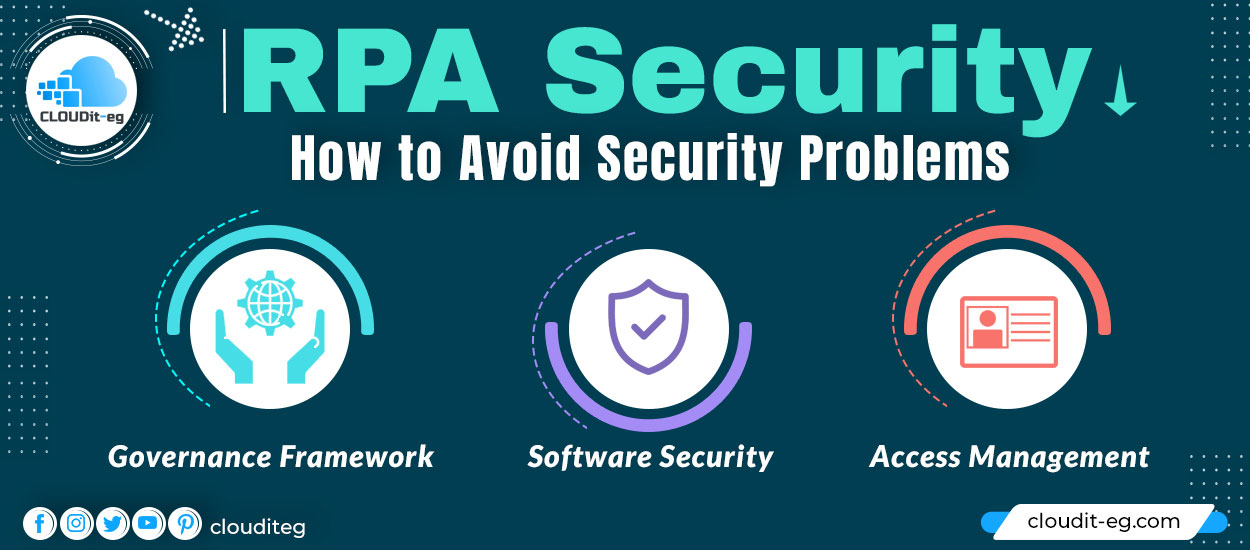A crucial component of a company’s digital strategy is Robotic Process Automation (RPA). The software robots should, among other things, minimize the human error rate and monitor compliance rules. To do this, digital employees need privileged access rights. In the worst case, the software robot itself can become a security risk. In this article, we will show you RPA Security and which security gaps can open up, and how they can be avoided or closed.
Risks and dangers of process automation
Despite all its undeniable advantages, RPA also offers attack surfaces that can be used to steal, destroy, or modify sensitive data and/or valuable information. To access unauthorized applications and systems, and to exploit vulnerabilities to gain unauthorized access to the company.
The misuse of privileged access data must be mentioned in the first place. In order to be able to automate regular business processes such as file transfer, order processing, or payroll accounting, the bot needs appropriate access authorizations that grant it access to confidential information (inventory lists, credit card numbers, addresses, financial information) about employees, customers, and suppliers of the company.
Risk factor user account
If the privileged credentials used by a software robot are left unprotected, the RPA process can quickly become a backdoor through which an attacker can maliciously gain access to the corporate IT infrastructure. By compromising a highly privileged robotics user account, the attacker could acquire powerful credentials that they can use in the same way as a software robot to log into the same business systems and applications and access the same data as the robot.
Access to sensitive data
It is unlikely that the access will be flagged as suspicious activity by the company’s security systems. The attacker has a free hand to read, write, manipulate, compromise, and copy any data that the system or application contains. Such as financial or customer data, intellectual property (IP), or other confidential or commercially sensitive information. Once they have access to the bot, they could train it to upload credit card information to a web-accessible database or steal sensitive intellectual property, making it difficult, if not impossible, to identify the true source of the leak.
The more bots, the higher the security risk
Since software robots can also be generated automatically, the greater the number, the greater the security risk. As the credentials used by robot scripts for privileged accounts significantly increase a potential threat if they are issued and stored insecurely. However, risks can also occur in the form of errors within the company.
E.g. when remote access to automated processes is given to people outside the company or when a new RPA project is successfully installed but not well encrypted. Fortunately, there are several ways to fix potential security holes.
How can you secure your RPA systems / avoid security risks?
In order to minimize or exclude security risks when implementing RPA, all technical and procedural factors of the entire RPA ecosystem must be taken into account. This means that the entire product life cycle from requirements, selection, architecture, implementation to ongoing operation must be considered.
The following questions are at the center of the security considerations:
- Will I be able to monitor and track bot activity to detect misuse of robotics that is affecting the confidentiality, integrity, or availability of other systems/data?
- Can I protect sensitive data from being deliberately or accidentally disclosed by bot creators and bot users?
- Can I trust that the data and results I get from my bots haven’t been modified or changed?
- Can I control access and protect privileged accounts used by the software robot and users?
Governance Framework first
In order to be able to answer the questions with yes, some basic measures should be taken. The first thing to do is to create a governance framework with roles and responsibilities for creating and securing the bots. Strategies and security requirements for the use of RPA within the guidelines and for monitoring compliance with security should then be developed. This also includes making bot developers and bot users more aware of the risks of RPA.
Comprehensive security analyzes at all levels
As part of the software and product security, it is advisable to carry out a risk analysis of the security architecture of the RPA solutions. The analysis should also include bot creation and bot control. The purpose of a bot design review, including a data flow analysis, is to verify that security controls are integrated into bot authentication, authorization, and input validation. Scan bots use dynamic tests or security fuzzing technology to help identify security weaknesses or security gaps.
The monitoring of sensitive data processed by the bots is used to check compliance with the usage guidelines. In addition, the log data should be collected from controllers and bot-runners in order to create an audit trail of the activities. And to monitor abnormal peaks in the activity and access of the bots to the various systems and the use of the privileged accounts.
The control center for credentials
The most important security measure is the assignment of different roles and access permissions in an RPA team. Which restricts the activities of each member and largely prevents fraudulent activities. To be able to assign the roles, an Active Directory integration is used, in which the team credentials are centralized for the administration. It is like a control center for login information. The use of Single Sign-On (SSO) with Lightweight Directory Access Protocol (LDAP) supports secure login to the RPA platform. The encryption of the credentials complements the Active Directory integration as a means of securing data usage. While role-based access reduces internal security risks, encryption ensures that the company is protected from external malicious attacks.
From risk factor to head of security
As always, there are two sides to the same coin when it comes to RPA security. RPA isn’t just a potential security risk that shouldn’t be underestimated. However, robot-supported process automation also has the potential to provide companies with sustainable support in various areas of IT security through automated controls and to contribute to improving security.
Bots can, for example, quickly and efficiently carry out conformity tests based on the guidelines for security settings on servers, firewalls, routers, and applications. They display the results of regular tests on the dashboard.
Cognitive learning can be used to:
- Automate the risk classification of applications and data.
- Gate-check security activities in the software development lifecycle (SDLC).
- Quickly and efficiently evaluate malware and threat alerts.
Correctly analyzing and responding to a phishing email can be a time-consuming process with just one email. That makes phishing analysis a great candidate for automation.
In addition, through the automation of processes, RPA reduces the security-related efforts associated with training employees and teaching security measures (e.g. password management, application of data protection regulations). By eliminating manual work, automation minimizes security risks at the macro level.
Conclusion
A not insignificant reason for the use of process automation in companies is the ability of bots to reduce the risk of errors in human work. Anyone who uses RPA to automate processes should in any case also deal with the further security risks that arise in connection with the use of data and the access authorization of the bots. Seen in this way, RPA projects should be implemented with care. A predictive implementation essentially means choosing an RPA product that enables proper, constant monitoring of the company’s internal security guidelines. At the same time supports the monitoring of the bots. The provision of role-based access authorizations to confidential data and data encryption is the most important means of minimizing security risks.




